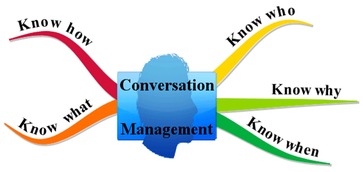Selling Power Magazine suggests that as we move from a pitch-driven economy to a conversation-driven economy, we need to pay more attention to how we plan, initiate, and manage customer conversations. In the past, salespeople were told that knowledge was power, and all they had to do was show up, identify the need, share their knowledge of how their product or service worked, and ask for the order.
The graphic below illustrates the approach to conversation management prior to the conversation economy. Salespeople needed to know how their product or service worked, what worked best in a given situation, on whom they should call, why prospects needed to know what, and of course, they needed to call their prospects at the right time.
In the Sales 2.0 era, the power has shifted from the company to the customer. When customers search for solutions, they turn first to the Internet and query social-media channels before connecting with a company or salesperson. The Internet has become the global watercooler, where people meet, exchange information, and form opinions that lead to business decisions.

The conversation economy isn’t only disrupting the old sales model; it is also disrupting old business models. Today, salespeople are meeting with prospects who are more informed and more reluctant to spend time with salespeople. Since salespeople are spending less time with prospects, customer conversation management has become more critical than ever. Unfortunately, most salespeople don’t receive training in the art and science of managing conversations with customers. Below is a map of the landscape that should lead to a collaborative conversation with a customer.
How to map a customer conversation:
- Problems to Avoid
Many salespeople stand in the way of their own success. The most common problems are lack of preparation, talking about unimportant subjects, engaging in circular conversation, or running out of time. Other problems include not having a conversation agenda, losing track of the objective, ignoring opportunities, insufficient probing, pursuing dead-ends, dumping information, deviating from the core topic, misinterpreting facts, and promoting incomplete ideas. - Selecting subjects to discuss is a good starting point. What’s more difficult to ascertain is how deep salespeople should go and how far the prospect is willing to go in the time available.
- Time is a critical factor. It is a good idea to ask the prospect before the meeting how much time he or she is willing to invest in the call. It is also a good idea to reconfirm that time frame before the meeting starts by asking, “You indicated that we’ll have about thirty minutes; is that still the case?”
- Create a positive climate for the conversation. Great salespeople bring positive energy to the meeting so they can cocreate the sale with the customer.
- Establish call priorities by determining what’s most important to the customer.
- Determine the ideal outcome of the conversation/relationship with the customer.
- Isolate the problems and obstacles that stand in the way of moving forward.
- Determine what other solutions the prospect has considered, and find out who else is involved in solving the current problem.
- Engage the client in cocreating the most efficient and economical solution to the current problem – as defined by the prospect.
- Detail and agree on the next steps to be completed.
- Determine what conditions need to be met before you can come to an agreement. (Plus, agree on a time frame.)
Peter and his colleagues works with Businesses in leadership, sales and service to clarify Business Sales & Marketing processes and development of sales people. Contact Peter at peter(AT)performancepartners.ie
Related Downloads:
